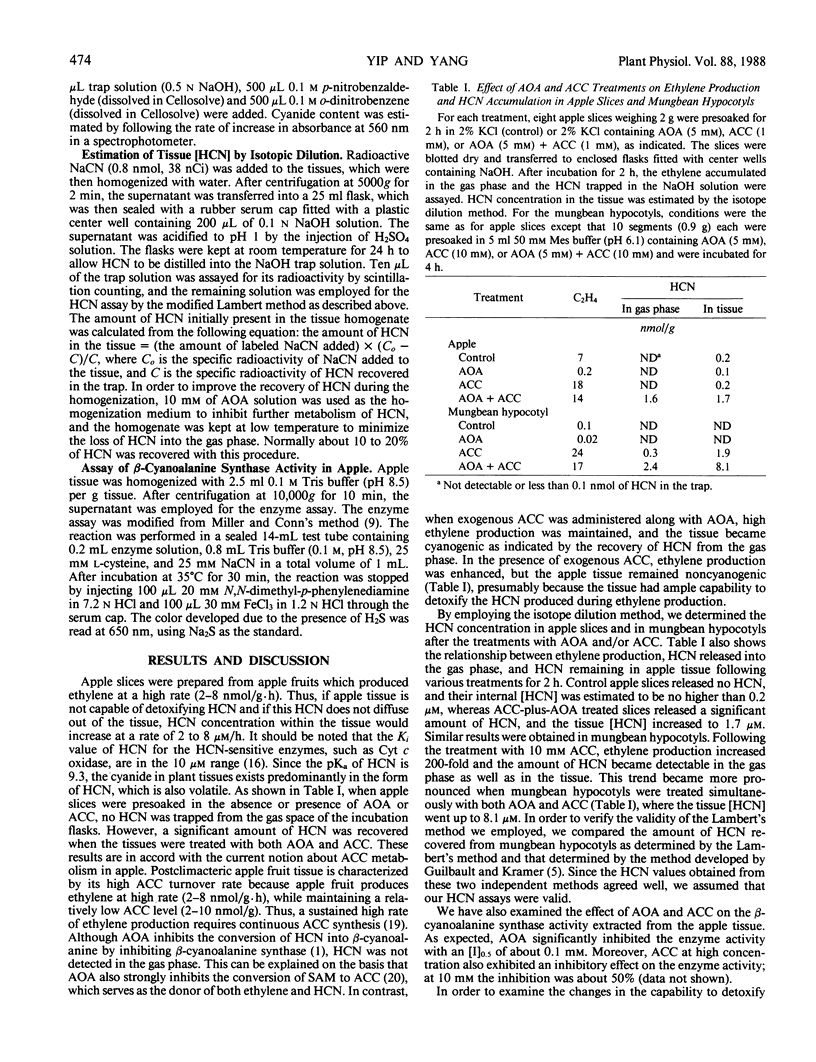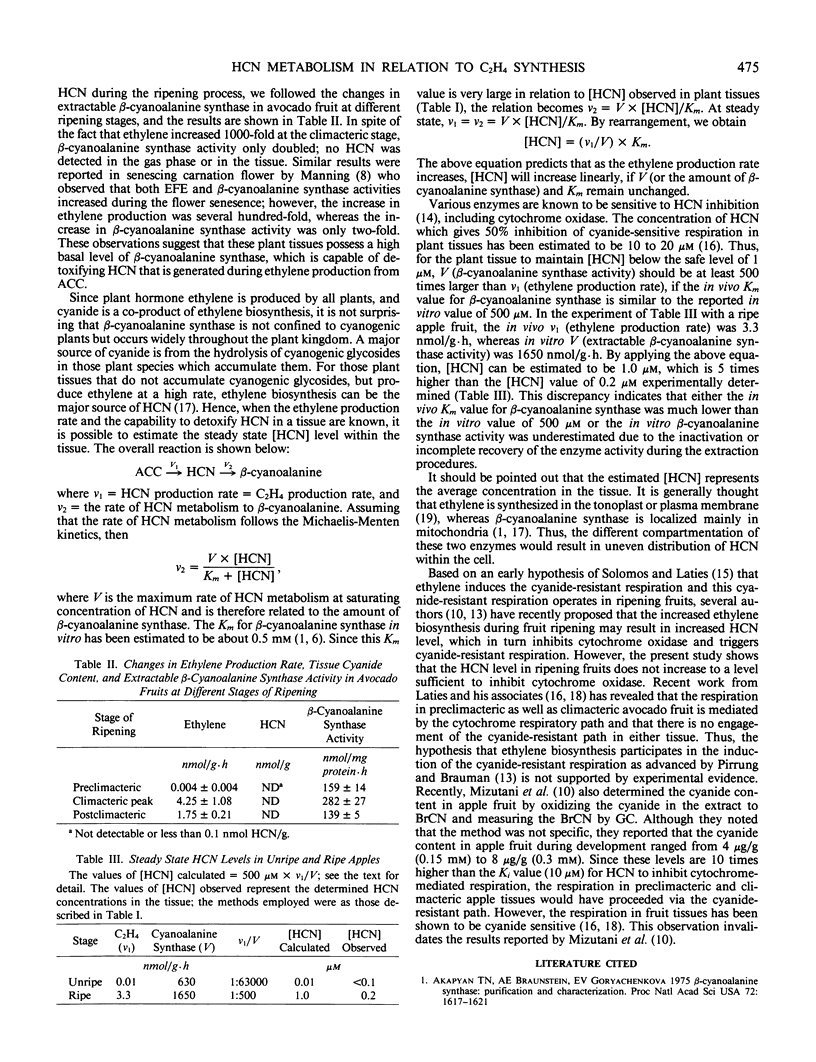Abstract
HCN is the putative product of C-1 and amino moieties of 1-aminocyclopropane-1-carboxylic acid (ACC) during its conversion to ethylene. In apple (Malus sylvestrus Mill.) slices or auxin-treated mungbean (Vigna radiata L.) hypocotyls, which produced ethylene at high rates, the steady state concentration of HCN was found to be no higher than 0.2 micromolar, which was too low to inhibit respiration (reported Ki for HCN to inhibit respiration was 10-20 micromolar). However, these tissues became cyanogenic when treated with ACC, the precursor of ethylene, and with 2-aminoxyacetic acid, which inhibits β-cyanoalanine synthase, the main enzyme to detoxify HCN; the HCN levels in these tissues went up to 1.7 and 8.1 micromolar, respectively. Although ethylene production by avocado (Persea gratissima) and apple fruits increased several hundred-fold during ripening, β-cyanoalanine synthase activity increased only one- to two-fold. These findings support the notion that HCN is a co-product of ethylene biosynthesis and that the plant tissues possess ample capacity to detoxify HCN formed during ethylene biosynthesis so that the concentration of HCN in plant tissues is kept at a low level.
Full text
PDF



Selected References
These references are in PubMed. This may not be the complete list of references from this article.
- Akopyan T. N., Braunstein A. E., Goryachenkova E. V. Beta-cyanoalanine synthase: purification and characterization. Proc Natl Acad Sci U S A. 1975 Apr;72(4):1617–1621. doi: 10.1073/pnas.72.4.1617. [DOI] [PMC free article] [PubMed] [Google Scholar]
- Blumenthal S. G., Hendrickson H. R., Abrol Y. P., Conn E. E. Cyanide metabolism in higher plants. 3. The biosynthesis of beta-cyanolanine. J Biol Chem. 1968 Oct 25;243(20):5302–5307. [PubMed] [Google Scholar]
- Floss H. G., Hadwiger L., Conn E. E. Enzymatic formation of beta-cyanoalanine from cyanide. Nature. 1965 Dec 18;208(5016):1207–1208. doi: 10.1038/2081207a0. [DOI] [PubMed] [Google Scholar]
- Hendrickson H. R., Conn E. E. Cyanide metabolism in higher plants. IV. Purification and properties of the beta-cyanolanine synthase of blue lupine. J Biol Chem. 1969 May 25;244(10):2632–2640. [PubMed] [Google Scholar]
- Miller J. M., Conn E. E. Metabolism of hydrogen cyanide by higher plants. Plant Physiol. 1980 Jun;65(6):1199–1202. doi: 10.1104/pp.65.6.1199. [DOI] [PMC free article] [PubMed] [Google Scholar]
- Peiser G. D., Wang T. T., Hoffman N. E., Yang S. F., Liu H. W., Walsh C. T. Formation of cyanide from carbon 1 of 1-aminocyclopropane-1-carboxylic acid during its conversion to ethylene. Proc Natl Acad Sci U S A. 1984 May;81(10):3059–3063. doi: 10.1073/pnas.81.10.3059. [DOI] [PMC free article] [PubMed] [Google Scholar]
- Solomos T., Laties G. G. Induction of ethylene of cyanide-resistant respiration. Biochem Biophys Res Commun. 1976 May 17;70(2):663–671. doi: 10.1016/0006-291x(76)91098-6. [DOI] [PubMed] [Google Scholar]
- Theologis A., Laties G. G. Relative Contribution of Cytochrome-mediated and Cyanide-resistant Electron Transport in Fresh and Aged Potato Slices. Plant Physiol. 1978 Aug;62(2):232–237. doi: 10.1104/pp.62.2.232. [DOI] [PMC free article] [PubMed] [Google Scholar]
- Wurtele E. S., Nikolau B. J., Conn E. E. Subcellular and Developmental Distribution of beta-Cyanoalanine Synthase in Barley Leaves. Plant Physiol. 1985 Jun;78(2):285–290. doi: 10.1104/pp.78.2.285. [DOI] [PMC free article] [PubMed] [Google Scholar]
- Yu Y. B., Adams D. O., Yang S. F. 1-Aminocyclopropanecarboxylate synthase, a key enzyme in ethylene biosynthesis. Arch Biochem Biophys. 1979 Nov;198(1):280–286. doi: 10.1016/0003-9861(79)90420-x. [DOI] [PubMed] [Google Scholar]


